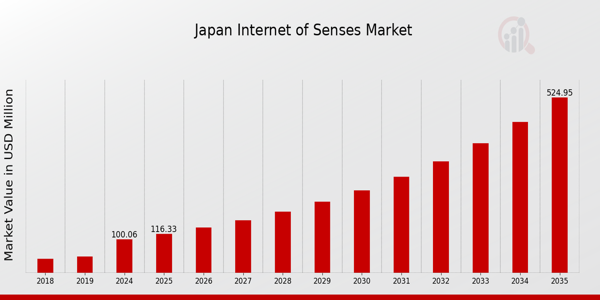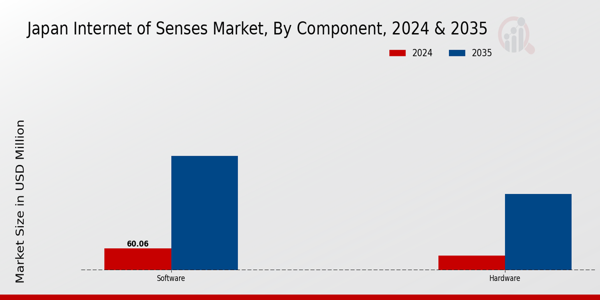Japan Internet of Senses Market Overview
As per MRFR analysis, the Japan Internet of Senses Market Size was estimated at 88.87 (USD Million) in 2023.The Japan Internet of Senses Market is expected to grow from 100.06(USD Million) in 2024 to 525 (USD Million) by 2035. The Japan Internet of Senses Market CAGR (growth rate) is expected to be around 16.263% during the forecast period (2025 - 2035).
Key Japan Internet of Senses Market Trends Highlighted
Innovations in sensory applications and technological improvements are driving considerable growth in the Japan Internet of Senses market, which is experiencing tremendous expansion over the past few years. A significant factor that is driving the market is the growing demand for immersive experiences in a variety of industries, including gaming, healthcare, and virtual reality, among others.
Companies have been encouraged to investigate potential in this sector as a result of the country's strong emphasis on research and development, which is backed by efforts taken by the government with the goal of supporting technological advancement.
Specifically, the demand for improved remote healthcare solutions is being driven by Japan's growing elderly population. These solutions should enable caregivers to connect with patients in more meaningful ways through the utilization of sensory technology.One of the opportunities that can be capitalized on in this market is the expanding utilization of augmented and virtual reality applications across a variety of industries. These applications have the potential to dramatically improve the user experience.
Additionally, there is the possibility for businesses to utilize sensory data in order to provide individualized services that cater to the tastes of individual customers, thereby resulting in increased levels of customer satisfaction.Furthermore, the cultural focus that Japan places on aesthetics and sensory experiences, such as traditional arts and cuisine, offers a one-of-a-kind opportunity for the incorporation of Internet of Senses technologies into lifestyle products and services.
Recent developments in Japan have brought to light a rise in the number of academic collaborations and partnerships between technology businesses in order to develop novel applications for the senses. Increasing the quality of life for inhabitants is the goal of the Smart City projects that are being implemented by the government.
These initiatives are further promoting the incorporation of Internet of Senses technologies into urban surroundings. This is an exciting sector to keep an eye on for future advances because businesses in Japan are incorporating multimodal experiences into their products and services in order to maintain their competitiveness and relevance as the digital landscape in Japan continues to expand.

Source: Primary Research, Secondary Research, MRFR Database and Analyst Review
Japan Internet of Senses Market Drivers
Rising Demand for Enhanced Customer Experience
In Japan, the push for improved customer experience across industries is becoming a prominent driver of growth in the Japan Internet of Senses Market. As consumer expectations evolve, companies are increasingly integrating sensory technologies to create immersive and personalized experiences.
According to a survey conducted by the Ministry of Economy, Trade and Industry of Japan, 78% of businesses recognize the importance of customer experience in driving sales, indicating a willingness to invest in technologies that enhance sensory perception.
Major organizations like Sony and Panasonic are at the forefront of developing Internet of Senses applications, contributing to the creation of engaging environments in retail, entertainment, and hospitality sectors.The implementation of sensory technologies, such as virtual reality and augmented reality, can boost customer engagement metrics by up to 50%, further propelling the market growth in this domain.
Advancements in Technology and R&D
Technological advancements in sensory technologies significantly influence the Japan Internet of Senses Market. The Japanese government has been fostering innovation through substantial investments in Research and Development (R&D). In FY 2022, the Japanese government allocated approximately JPY 2 trillion to R&D initiatives, aiming to enhance the nation's technological capabilities.
Companies like Fujitsu and NTT Docomo are leveraging these investments to develop cutting-edge sensory technology applications, which range from smart homes to health monitoring systems. The rapid evolution of hardware and software in this sector can reduce costs and improve performance by at least 30%, thus making sensory technologies more accessible to various market segments.
Growth in Smart Home Technologies
The increasing adoption of smart home technologies in Japan presents a substantial growth driver for the Japan Internet of Senses Market. According to a report by the Ministry of Internal Affairs and Communications, the smart home market in Japan is projected to grow at a compound annual growth rate (CAGR) of 18% through 2025.
Companies like Sharp Corporation and Hitachi are investing in products that integrate sensory technologies to enhance user experience in home automation.
The integration of aromatherapy diffusers, ambient lighting, and sound control systems enhances the sensory environment within homes. This market's expansion indicates a consumer preference for environments that cater to all five senses, driving market demand further.
Japan Internet of Senses Market Segment Insights
Internet of Senses Market Component Insights
The Japan Internet of Senses Market is rapidly evolving, with the Component segment playing a pivotal role in shaping its trajectory. This segment is broadly categorized into Hardware and Software, each contributing distinctly to the market's overall framework.The remarkable growth of the Internet of Senses in Japan can be attributed to various factors, including advancements in technology and the increasing adoption of sensory experiences across industries.
Japan, known for its technological innovation, is seeing heightened interest in immersive experiences that combine multiple senses, driving demand for sophisticated hardware equipped with sensors, haptics, and input devices that enhance user engagement.
Hardware in this segment is critical, as it forms the backbone of sensory technologies, integrating physical components such as augmented reality (AR) devices, virtual reality (VR) headsets, and interactive systems. These devices not only enhance user interaction but also facilitate the development of applications that cater to various sectors, including healthcare, entertainment, and education.
Meanwhile, Software solutions provide the necessary frameworks and applications that enable real-time processing and interpretation of sensory data. This includes the creation of rich content and interactive experiences that captivate users, making it a significant driver of the Japan Internet of Senses Market.As the market continues to expand, the interplay between hardware and software will become increasingly important. The integration of artificial intelligence and machine learning technologies in software is paving the way for more personalized and responsive sensory experiences.
Moreover, the rise of 5G technology in Japan is anticipated to enhance the performance and connectivity of sensory devices, offering users a seamless experience that marries multiple sensory modalities.Both hardware and software components are complemented by strong government support for technological advancements, bolstering efforts in research and development, and fostering innovation across the market.
With significant investment flowing into these areas, organizations in Japan are uniquely positioned to lead the charge in providing cutting-edge solutions that harness the power of the Internet of Senses.The synergy between hardware and software not only addresses current market demands but also opens new avenues for creativity and collaboration in mediums such as digital art, gaming, and therapeutic environments.
As a result, the Component segment stands to significantly impact the overall dynamics of the Japan Internet of Senses Market, positioning it as a crucial player in the future of digital interaction and experience. The health of the market will depend on the ability to adapt to emerging trends and leverage technological advancements to meet the evolving preferences of consumers.

Source: Primary Research, Secondary Research, MRFR Database and Analyst Review
Internet of Senses Market Technology Insights
The Japan Internet of Senses Market, particularly within the Technology segment, is experiencing noteworthy growth driven by advancements in digital technologies. In this segment, Artificial Intelligence, Virtual Reality, and Augmented Reality are pivotal components contributing to enhanced experiences in sensory interactions.
The popularity of Artificial Intelligence is emerging due to its capability to personalize and adapt user interactions, while Virtual Reality is reshaping experiences across entertainment and training sectors, offering immersive environments for users.Augmented Reality, on the other hand, bridges the gap between the virtual and real world, making it significant in enhancing operational efficiencies and user engagement in various applications, including education and retail.
The overall market growth can be attributed to increasing consumer demand for interactive and engaging technologies, alongside the accelerating digitization trend across industries in Japan.Moreover, the integration of these technologies not only enhances user experience but also opens up avenues for innovative applications, thus driving further interest and investment in the Japan Internet of Senses Market, making it a focal point for tech development and application.
Internet of Senses Market Application Insights
The Japan Internet of Senses Market is rapidly evolving, with diverse applications spanning Hearing, Sight, Smell, Taste, Touch, and Mind. This dynamic market is underpinned by advances in technology and consumer demand for immersive experiences.
The Hearing segment is particularly significant, driven by innovations in audio technology and increasing usage in entertainment and communication sectors. Meanwhile, the Sight segment benefits from the advancements in augmented and virtual reality, reshaping how consumers interact with digital content.
The Smell and Taste segments, although less traditional, are gaining traction through applications in food technology and marketing, enhancing sensory engagement in experiential consumption. Touch technology is also crucial, creating new avenues in virtual interactions and haptic feedback systems.
The Mind segment focuses on cognitive and emotional engagement, tapping into neuroscience to enhance user experiences. As the industry continues to develop, the Japan Internet of Senses Market data indicates a strong potential for growth and diversification across these applications, revealing opportunities and challenges that industries must navigate effectively.
Internet of Senses Market End User Insights
The Japan Internet of Senses Market is increasingly being shaped by its End User segment, which encompasses diverse fields such as Consumer, Enterprise, and Retail. The Consumer segment is becoming prominent as individuals seek immersive experiences through advanced technologies in daily activities and entertainment.
Enterprises are leveraging the Internet of Senses to enhance productivity and foster innovation, responding to the growing demand for digital transformation in the workplace. Retail also plays a crucial role, with businesses focusing on creating engaging shopping experiences through sensory technology, aiming to capture consumer attention and boost sales effectively.
This segment responds well to the evolving market trends, driven by a tech-savvy population increasingly willing to adopt advanced sensory technologies. The overall growth is evident as Japan emphasizes innovation and technological adoption across its economy, creating ample opportunities for development in the Internet of Senses Market.As this market further develops, it is expected that all End User categories will increasingly rely on sensory integrated solutions, which will significantly influence consumer behavior and enterprise strategies in Japan.
Japan Internet of Senses Market Key Players and Competitive Insights
The Japan Internet of Senses Market is rapidly evolving, driven by advancements in technology and a growing consumer demand for immersive digital experiences. This market encompasses a wide range of products and services designed to enhance sensory engagement through digital platforms, including augmented reality, virtual reality, and multisensory interfaces.
Competitive insights into this market reveal a landscape characterized by innovation, collaboration, and strategic partnerships as companies strive to lead in offering unique experiences that effectively integrate sensory inputs.The increasing penetration of IoT devices, coupled with Japan's tech-savvy population, positions the market for significant growth, where various players are vying for market share and aiming to address the evolving demands of consumers.
KDDI maintains a strong presence within the Japan Internet of Senses Market through its focus on delivering high-quality telecommunications services and innovative solutions. The company stands out with its ability to leverage existing infrastructure to incorporate sensory technologies, enhancing user experiences across various consumer sectors.
KDDI's strengths lie in its robust network capabilities and commitment to research and development, which allow for the seamless integration of IoT solutions with sensory engagement. The firm also forges strategic alliances with technology providers and startups to enhance its offerings, ensuring it remains competitive in this dynamic landscape.
KDDI's comprehensive approach to creating a connected environment leads to enhanced service delivery and strengthened customer engagement, aligning well with the market's growth trajectory.NEC plays a pivotal role in the Japan Internet of Senses Market, focusing on delivering a wide array of innovative solutions that promote enhanced sensory interactivity. The company is recognized for its strong portfolio of products and services, ranging from advanced analytics tools to cutting-edge sensory technology applications that respond to consumer needs.
NEC's strengths lie in its extensive experience in the tech sector and its commitment to innovation, allowing it to effectively position itself within the competitive landscape. The company has undertaken various mergers and acquisitions to bolster its capabilities, enhancing its market presence and access to new technologies that complement its existing offerings.By focusing on key areas such as smart cities, security, and communications, NEC aims to provide value-added solutions that fulfill the demands of consumers seeking immersive sensory experiences in Japan.
Key Companies in the Japan Internet of Senses Market Include:
- KDDI
- NEC
- Mitsubishi Electric
- NTT Data
- Okinawa Cellular Telephone Company
- Yamaha
- Panasonic
- Rakuten
- LINE Corporation
- Sony
- Hitachi
- Denso
- Sharp
- Fujitsu
Japan Internet of Senses Market Developments
KDDI made the announcement in April 2025 that it would be participating in Expo 2025 in Osaka, Kansai, Japan, in order to demonstrate its various technological achievements related to the Internet of Senses.During the presentation, the company highlighted its efforts to integrate sensory experiences into digital platforms with the intention of increasing user engagement and connection. KDDI's aim is to be the driving force behind the development of immersive technologies in Japan, and this program aligns with that vision.
A distributed MIMO technology system was exhibited by NEC in March of 2025. This demonstration was carried out in partnership with NTT Corporation and NTT DOCOMO. The purpose of this technique is to prevent the erosion of communication quality in high-frequency bands, which will contribute to the improvement of sensory experiences in digital communications.
A visual inspection program called MELSOFT VIXIO was introduced by Mitsubishi Electric in June of 2025. This software makes use of artificial intelligence to do intuitive and sensory inspections of flaws in industrial processes. This new breakthrough demonstrates the company's dedication to incorporating sensory technology into various operational applications in the industrial sector.
The report titled "Technology Foresight 2025" was published by NTT Data in the month of May 2025. This research detailed the company's strategies and advancements relevant to the Internet of Senses domain. The research highlights the fact that NTT Data is concentrating on the development of sensory technologies in order to improve user experiences.
Okinawa Cellular Telephone Company made the announcement in February 2025 that it would be working with locally based technology firms to develop Internet of Senses applications that were specifically designed for the Okinawa region. The purpose of this alliance is to provide regionally specific sensory experiences in order to encourage technical breakthroughs in the region.
Japan Internet of Senses Market Segmentation Insights
Internet of Senses Market Component Outlook
Internet of Senses Market Technology Outlook
-
- Artificial Intelligence
- Virtual Reality
- Augmented Reality
- Others
Internet of Senses Market Application Outlook
-
- Hearing
- Sight
- Smell
- Taste
- Touch
- Mind
Internet of Senses Market End User Outlook
-
- Consumer
- Enterprise
- Retail
| Report Attribute/Metric Source: |
Details |
| MARKET SIZE 2023 |
88.87(USD Million) |
| MARKET SIZE 2024 |
100.06(USD Million) |
| MARKET SIZE 2035 |
525.0(USD Million) |
| COMPOUND ANNUAL GROWTH RATE (CAGR) |
16.263% (2025 - 2035) |
| REPORT COVERAGE |
Revenue Forecast, Competitive Landscape, Growth Factors, and Trends |
| BASE YEAR |
2024 |
| MARKET FORECAST PERIOD |
2025 - 2035 |
| HISTORICAL DATA |
2019 - 2024 |
| MARKET FORECAST UNITS |
USD Million |
| KEY COMPANIES PROFILED |
KDDI, NEC, Mitsubishi Electric, NTT Data, Okinawa Cellular Telephone Company, Yamaha, Panasonic, Rakuten, LINE Corporation, Sony, Hitachi, Denso, Sharp, Fujitsu |
| SEGMENTS COVERED |
Component, Technology, Application, End User |
| KEY MARKET OPPORTUNITIES |
Augmented reality applications, Smart home integration, Healthcare sensory solutions, Enhanced virtual reality experiences, Multi-sensory entertainment platforms |
| KEY MARKET DYNAMICS |
Technological advancements, Growing consumer adoption, Increasing applications in industries, Strong government support, Enhanced user experiences |
| COUNTRIES COVERED |
Japan |
Frequently Asked Questions (FAQ):
The Japan Internet of Senses Market is expected to be valued at 100.06 million USD in 2024.
By 2035, the market valuation of the Japan Internet of Senses Market is projected to reach 525.0 million USD.
The expected CAGR for the Japan Internet of Senses Market from 2025 to 2035 is 16.263%.
Both hardware and software components are expected to see significant growth, with hardware projected to reach 210.0 million USD and software 315.0 million USD by 2035.
Major players in the Japan Internet of Senses Market include KDDI, NEC, Mitsubishi Electric, NTT Data, and Sony.
Regional dynamics are expected to play a crucial role in market growth, driven by advancements in technology and increasing consumer demand.
Key applications of the Japan Internet of Senses Market include enhanced communication, immersive gaming experiences, and smart city solutions.
Challenges such as regulatory compliance, technology integration, and market competition are anticipated for the Japan Internet of Senses Market.
Growth drivers include advancements in sensory technology, increased investment in IoT infrastructure, and rising demand for immersive experiences.
In 2024, the hardware segment is valued at 40.0 million USD and the software segment at 60.06 million USD in the Japan Internet of Senses Market.
















